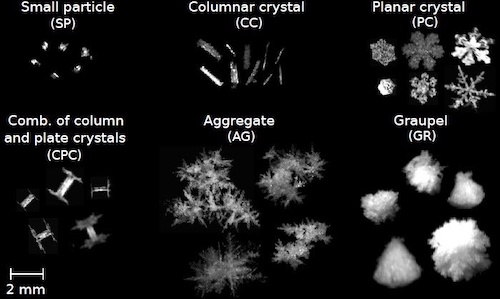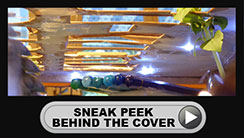
This week the forecast is snow and you will have the opportunity to observe the snowflakes more closely. What do you know about these beautiful miniature ice sculptures? Thanks to MétéoSuisse for giving knowitall.ch permission to translate their article published in January 2021.
No two snowflakes are alike. An old adage that, on closer inspection, has a good deal of truth to it. The appearance of a snowflake, which can be seen on your coat sleeve or glove, actually tells the story of its life cycle: its birth in a cloud, its descent, its interaction with other crystals, and the atmospheric conditions that see a development that can be read through the below image.

Photos of snow crystals and snowflakes. Source: Praz et al, 2017 (DOI:10.5194/amt-10-1335-2017) Source: Libbrecht, 2005 (DOI:10.1088/0034-4885/68/4/R03)
The formation of a snow crystal
The main factors influencing the formation of various snow crystals are the humidity of the air and the temperature. Different combinations of these two parameters lead to different types of crystals. For example, ice crystals can form in the shape of small bars, six-pointed flakes resembling small tiles, or dendritic forms, such as the snow star on the Christmas tree, which inevitably comes to mind.
The formation of snow crystals depends on the temperature and saturation of water vapour. On the below graph, with temperature on the x-axis and water vapor saturation on the y-axis, different shapes of ice crystals (e.g. plates, dendrites, needles, columns) are shown.

Source: Libbrecht, 2005 (DOI:10.1088/0034-4885/68/4/R03)
Once the crystals are formed?
As soon as the crystal is formed and sufficiently large and heavy, the crystal will start to fall slowly towards the ground, at first with a speed of a few centimetres per second. During its long and slow journey to the ground, the crystal will encounter, for a certain period of time, temperature and humidity conditions different from those which prevailed at the time of its formation and which will inevitably transform it. A crystal such as the CPC in the second image (how poetic!), a combination of small bars and small plates, probably started out as a small bar and then passed through a layer of atmosphere where its ends became plate-shaped.
Interactions
The metamorphosis of crystals under the influence of temperature and humidity is a gentle and very slow process. However, there are two more violent and turbulent types of interactions: aggregation and riming (image below). Aggregation is the result of a collision of two or more crystals, which then form a larger and more complicated complex: this can be called a snowflake. Another interesting process is the formation of frost, which occurs when a snow crystal or snowflake comes into contact with water droplets in fog or air, and these immediately freeze on its cold surface. To make a culinary comparison: like dipping a Yule Log in icing sugar.

Enlarged display: Icing intensity ("riming") increasing from left to right. This image shows different degrees of icing, from 0 (snow crystal without icing) to 1 (melted snow). Source: Praz et al, 2017 (DOI:10.5194/amt-10-1335-2017)
What if we listened to the history of snow?
Once we are aware of all these little nuggets of information, we see crystals and snowflakes in a different way. Next time it snows, try to decipher the story and imagine all the interactions that have influenced and changed the appearance of these snowflakes. Since chaos dominates all atmospheric processes, each flake is slightly different from all the others.









